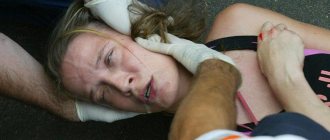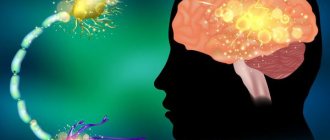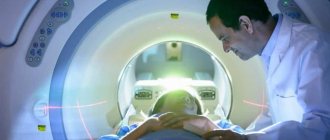The main method of treating epilepsy is drug therapy in combination with a proper lifestyle and diet. A diet for epilepsy is followed in order to maintain the effectiveness of medications, as well as to normalize the general condition of the patient.
The ketogenic diet is a diet that aims to produce increased amounts of ketone bodies in the body, which in turn are a treatment for epilepsy, since when they enter the brain, ketone bodies have an anticonvulsant effect.
The ketogenic diet, when strictly followed, has a positive result in 70% of cases. This type of nutrition is especially effective for children, despite the fact that it is most difficult for a child to adhere to this diet. However, despite its high effectiveness, such a diet should be formulated and monitored by a specialist in order to avoid negative effects on other internal organs and systems of the body.
A team of neurologists and nutritionists at the Yusupov Hospital works with patients on an individual approach, which allows them to provide attention to each individual based on the patient’s medical history and indicators. Our doctors have extensive experience in successfully treating epilepsy in adults thanks to the use of the latest techniques and medications in their medical practice.
Ketogenic diet menu for adults
The main principle of the ketogenic diet is the ratio of proteins and carbohydrates relative to fats - the balance should correspond to a value of 1 to 4, while the amount of protein consumed should be several times higher than the amount of carbohydrates.
A healthy person receives energy from carbohydrates - due to their oxidation, ATP (adenosine triphosphate) is released, which in turn is fuel for our body. If the amount of carbohydrates is reduced, the body begins to obtain energy from fat. The ketogenic diet involves restructuring the body to oxidize fats, which form ketone bodies in large quantities. Ketone bodies travel through the bloodstream to the brain, where they have an anticonvulsant effect. This diet is prescribed exclusively by a doctor for medicinal purposes, and is under no circumstances used for weight loss purposes, since an incorrectly prescribed diet can have serious consequences for some systems within the body.
During the diet, the regimen can be adjusted based on the patient’s personal indicators or wishes. The basis of such a diet should be an abundance of healthy fats, which are recommended to be obtained from the following foods:
- fatty sea fish;
- beef, lamb, pork;
- salo;
- butter and cream;
- vegetable oils - olive, coconut, flaxseed, sea buckthorn and sesame;
- seeds, nuts;
- avocado.
Institute of Child Neurology and Epilepsy
For many centuries, the search for various methods of treating epilepsy has continued. Antiepileptic drugs are highly effective for epilepsy, but they have a variety of, sometimes very serious, side effects. It is also necessary to take into account the fact that during severe attacks, doctors are forced to prescribe several medications at the same time, which means that the likelihood of toxic effects increases.
Scientists are constantly striving to create new effective and safe treatments for epilepsy. There is a method for treating severe forms of epilepsy that has almost no side effects and can be comparable in effectiveness to modern medications. This is the so-called ketogenic diet, which is widespread today in Europe and America. Typically, the ketogenic diet is used for severe, difficult-to-treat forms of epilepsy, including Lennox-Gastaut syndrome and partial forms of epilepsy. The diet was developed in the 20s of the last century in the USA, when nutritionists and pediatricians drew attention to the special biochemical processes occurring in the human body during fasting, which ultimately lead to a decrease in epileptic seizures.
They tried to treat epilepsy with the help of fasting back in the Middle Ages (then it was called “treatment by prayer and fasting”), and sometimes this practice actually led to an improvement in the condition of patients. The ketogenic diet does not require prolonged fasting, especially since it would be extremely difficult for a small child to abstain from food for even a day. The main content of the new treatment method is a specially calculated diet for the child, in which the amount of carbohydrates (sugar) is reduced and the bulk of the food consists of fats. When food is digested, fats are converted into specific metabolic products, so-called ketone bodies, which enter the brain and provide an anticonvulsant effect. When prescribing a ketogenic diet, the diet for each child is calculated only by a doctor strictly individually, taking into account the diagnosis, age and weight of the child, and his nutritional needs. The content of basic nutrients (proteins, fats, carbohydrates) in food is selected in a certain ratio, which is determined by the doctor. During treatment, this ratio may change, so the patient must be constantly under the supervision of the attending physician, who, if necessary, makes dietary adjustments.
The patient's diet includes various types of fatty foods - bacon, heavy cream, vegetable oils (for example, flaxseed). In countries where the use of the ketogenic diet has become widespread, the food industry produces many specialty products that can provide a varied and nutritious menu. For those starting a course of treatment, nutritionists have developed special milkshakes with a lot of fat, which children can not only drink, but also eat frozen like ice cream. This helps the child get used to fatty foods and creates the necessary biochemical changes in the body that provide an antiepileptic effect.
During the treatment process, the doctor requires great skill in creating a menu, otherwise the child will quickly get bored with the monotonous diet and may refuse to eat altogether. Typically, the ketogenic diet is used in children from 1 to 12 years of age, but there is evidence of its effectiveness in adults, as well as in children in the first year of life, starting from 4 months of age. At an early age (up to 1 year), it is difficult to choose the necessary products that would allow the child to grow and develop normally.
The use of a ketogenic diet can reduce the frequency of epileptic seizures (in some cases, achieve complete remission), improve the memory and attention of patients. In addition, an important advantage of the ketogenic diet is the ability to reduce the dose of antiepileptic drugs taken, thereby avoiding their side effects. In some patients, the effect of the ketogenic diet may be so pronounced that it allows the drug to be discontinued completely.
The effect of the ketogenic diet occurs gradually during the first 3 months after starting its use. Typically, long-term treatment is required (for several years, usually 2-3 years), after which a stable improvement is generally observed, which persists even with a normal diet. Thus, there is no need to follow a ketogenic diet for life.
The ketogenic diet has few side effects. Basically, these are temporary dysfunctions of the gastrointestinal tract (constipation) and a lack of certain vitamins, which can be easily corrected with the help of modern vitamin-mineral complexes. Inconveniences include the need for daily monitoring of the child’s nutrition, the selection of special foods and the exclusion of sugar from food, which causes particular protest from patients.
Concerns are sometimes expressed that the use of high-fat foods increases the likelihood of atherosclerosis. Apparently, such phenomena can be observed in people with a hereditary predisposition, but manifestations of atherosclerosis in children receiving a ketogenic diet have not yet been found, especially since after completing the diet, all biochemical processes quickly return to normal.
Currently, more and more new centers dedicated to the ketogenic diet are being created in different countries of the world. Once again, it should be emphasized that the prescription and administration of the ketogenic diet is carried out only under the supervision of a doctor specializing in the field of this treatment method.
Our Center does not treat epilepsy using the ketogenic diet method. This method has not been developed in Russia. The first experience of using the ketogenic diet was obtained at the Scientific and Practical Center for Medical Care for Children in Solntsevo (Aviatorov Street 38).
A consultation is possible in France (Dr. O. Dulac) to select a ketogenic diet.
Dangerous products for epilepsy
A diet for epilepsy in adults involves a complete abstinence from alcohol.
Beer, weak wines and other alcoholic drinks can not only provoke a seizure, but also aggravate the patient's condition. The most dangerous thing is drinking large quantities of alcohol in a short period of time. Seizures in epileptics most often occur due to drinking large quantities of liquid. Many neurologists recommend that patients reduce fluid intake and also prescribe medications to remove it from the body.
For people suffering from epilepsy, it is important to avoid overeating and also limit the consumption of simple sugars. A diet for epilepsy is aimed at reducing the load on the human body and preventing the development of seizures. You should limit your use as much as possible:
- refined sugar, honey;
- flour products (bread, rolls, cookies, pasta);
- various cereals;
- vegetables and fruits containing large amounts of starch (mainly root vegetables);
- alcohol;
- various sauces with a high percentage of carbohydrates.
Refusal of harmful products can not only reduce the likelihood of repeated epileptic attacks, but also improve the general condition of the patient.
It should be understood that even rare minimal violations of nutritional rules threaten the poor performance of the entire diet. It is important to turn this diet into a lifestyle. Nutritionists at the Yusupov Hospital try to make the ketogenic diet as suitable as possible for each patient. Our doctors closely monitor indicators and tests, adjust the patient’s diet if it becomes necessary.
Make an appointment
Is visiting discos dangerous for people with epilepsy?
This question is probably most relevant for adolescents and young patients. It is known that light and music effects can provoke an attack in photosensitive patients; however, not all elements of light music are dangerous, but only stroboscopic (often flickering) bright glare in a dark room. The brightness and frequency of the flash are important factors influencing the likelihood of an attack.
It is important to note that visiting discos is also associated with other factors that provoke the development of attacks - lack of sleep, fatigue and alcohol intake.
Ketogenic diet menu for adults
The diet of a person with epilepsy should be as balanced as possible.
Patients should eat large quantities of food with coarse fibers, as well as with a high content of folic acid, since epileptics often have a severe deficiency of this element due to prolonged use of medications. As a rule, the ketogenic diet is not prescribed to all patients, but only to those who do not have a positive reaction to the use of antiepileptic drugs. This diet is most effective in childhood. However, despite the high effectiveness of this diet, it has a number of contraindications:
- cerebrovascular pathologies;
- encephalopathy;
- kidney and liver diseases;
- diseases of the endocrine system (or predisposition to them);
- mitochondrial pathologies;
- diseases of the cardiovascular system.
It is most effective to follow this diet in a hospital setting.
The Yusupov Hospital provides its patients with a complete diet in the hospital, based on the testimony of the attending doctor. Since the diet is quite difficult to follow, within the hospital walls we provide maximum comfort to our patients so that they do not feel discomfort from a change of environment. The diet itself begins with a three-day fast. During this time, metabolism accelerates and the body is rebuilt, completely cleansing itself and preparing for a new diet. In the first three days, the patient is allowed to drink only clean water without gas. After which, under the strict supervision of a doctor, the required amount of fats and proteins begins to be introduced into the diet. The menu for each patient is compiled individually to eliminate the risk of complications. A sample menu on a ketogenic diet looks like this:
- first meal (breakfast) - scrambled eggs with ham or bacon, salad of non-starchy vegetables, dressed with olive oil;
- second meal (lunch) - stewed or fried pork or beef, steamed vegetables;
- third meal (dinner) - fatty sea fish (salmon, mackerel, herring), fresh vegetables and hard cheese.
The duration of this diet is regulated by the doctor. It takes at least 3-4 weeks to get results. If the diet gives a positive result, it is recommended to stick to this diet for the rest of your life.
Keto diet for epilepsy - general contraindications
The keto diet is not intended for people suffering from endocrinological diseases (diabetes mellitus, metabolic pathologies), liver diseases, kidney diseases, or cardiovascular diseases. It should not be used if an important medical operation is planned.
On the eve of switching to the keto diet, you need to gradually adjust your diet. It is recommended to avoid too strong tea and coffee, alcohol, smoked foods and spicy foods. It is advisable to reduce carbohydrates gradually so as not to put the body into a stressful state.
Ketogenic diet for children
For children, the ketogenic diet is indicated only after one year in order to avoid developmental delays and serious complications of internal biorhythms.
For normal development, children must eat all trace elements and vitamins in sufficient quantities. The ketogenic diet involves a significant reduction in carbohydrates, which can inhibit a child’s growth. Therefore, the child must additionally consume vitamin complexes. The ketogenic diet for children will be approximately the same as for adults. However, children are also prescribed special fatty milk drinks, which “accustom” the child’s body to consuming large amounts of fat. The milk drink can be consumed in the form of a shake or ice cream.
The ketogenic diet in children requires constant monitoring. Children who adhere to this diet may experience delayed physical development and loss of body weight. Regular visits to the doctor and dietary adjustments will help prevent the deterioration of the little patient’s condition.
Keto diet for children with autism
To date, there are only a few studies that have shown the success of the keto diet for children with autism. Basically, in such children it is recommended to follow a gluten-free or casein-free diet, or the keto diet itself is used as an addition to the main diet of the sick child.
There is an assumption that the etiology of autism involves the same metabolic disorders as in epilepsy, so the ketogenic diet can give positive results when used in autistic children. However, problems associated with various eating disorders arise in treating children with autism with the keto diet. Children with autism suffer from many intestinal or eating disorders.
For patients with autism, it is important to exclude easily fermentable foods and carbohydrates that cause disturbances in the gastrointestinal tract, but also include medium-chain triglycerides, such as coconut oil, in the menu. This is why the keto diet for children with autism has found its way to date. However, it should be remembered that the evidence base is still minimal.
Treatment of epilepsy in Moscow
Epilepsy is not a death sentence, but a disease that, with proper treatment, allows a person to live a full life without any deprivation. To maintain a good quality of life, patients with epilepsy are strongly recommended to regularly visit a neurologist and undergo all necessary examinations.
At the Yusupov Hospital, treatment of epilepsy is performed by experienced neurologists and epileptologists who are fluent in various effective methods for eliminating this pathology. Professional nutritionists, based on the recommendations of the attending physician, create a nutrition plan that will be as safe as possible for the patient. The course of treatment for epilepsy at the Yusupov Hospital can significantly reduce the manifestations of the disease and achieve stable remission.
You can make an appointment with neurologists, epileptologists, nutritionists, undergo an examination, and get more information by calling the Yusupov Hospital.
Make an appointment









